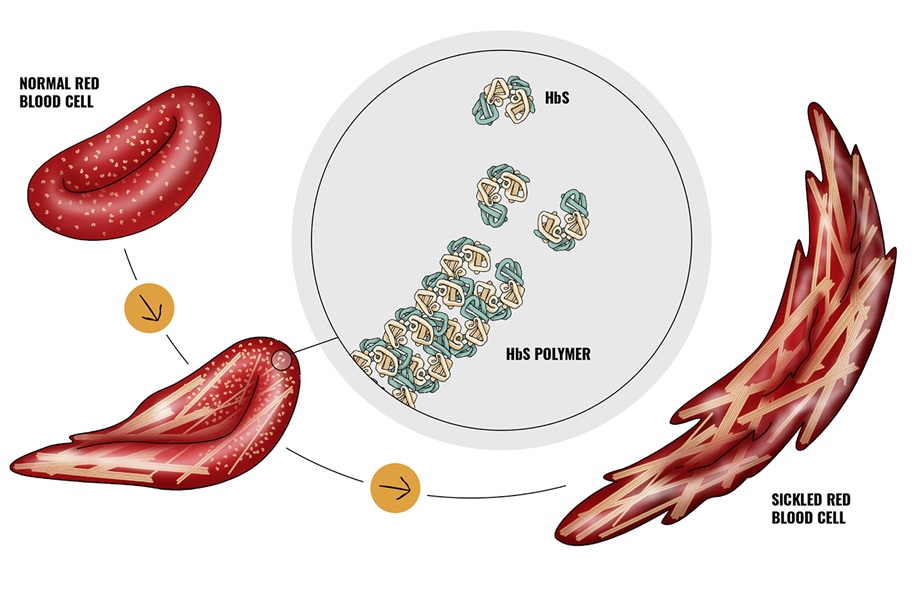What is Sickle Cell?
Sickle cell is a progressive and unpredictable genetic disorder that affects red blood cells. Learn more about what causes this rare condition.
Genetic disease
a disease that is caused by a change, or mutation, in someone’s DNA sequence
Hemoglobin
a protein in red blood cells that helps carry oxygen throughout the body
What Causes Sickle Cell?
Sickle cell is a progressive and unpredictable genetic disease caused by a change (mutation) in both copies of the HBB gene that you inherit from your parents. This change affects the hemoglobin protein, which causes people with sickle cell to produce an abnormal form of hemoglobin called hemoglobin Sickle (HbS). There are hundreds of variations in the HBB gene that can affect the hemoglobin protein. Although HbS is the most common abnormal form of hemoglobin, there are other variations. Because of this, there are different types of sickle cell.
In sickle cell, HbS proteins clump together, causing red blood cells to become sickle shaped, sticky, rigid, and fragile. You can think of red blood cells as a water balloon: healthy red blood cells are flexible and can flatten and squish through even the smallest of blood vessels. Sickled red blood cells, however, have a harder, less flexible consistency—like a water balloon full of ice chips instead of water—causing them to break apart, damage vessels, slow and/or stick and block blood flow throughout the vessels of the body. This leads to the symptoms and complications associated with sickle cell.

Who Gets Sickle Cell?
Sickle cell affects millions of people throughout the world across a wide range of ethnicities. And although in the United States it is often perceived as a disease that only affects the Black community, it affects people of all races.
“Sickle cell is a blood disease and it can affect people of any ethnic background...The reality is that anyone can get this disease, and it can impact you or your family, and you might not care until it matters.”
— Rae, Parent
Prevalence of Sickle Cell
Estimates for the prevalence of sickle cell in the United States rely on consistent and complete reporting by universal newborn screening information. Although newborn screening has expanded in the past decade, differences in how information is collected varies by state, including how race and ethnicity are classified. These inconsistencies make it difficult to accurately estimate sickle cell prevalence information across the entire United States.
Although it is classified as a rare condition, as of 2019 the Centers for Disease Control and Prevention (CDC) estimates that sickle cell impacts ~100,000 Americans. Of these:
~1 of 365 Black births
~1 of 16,300 Hispanic American births
~1 of 25,800 Asian/Pacific Islander births*
~1 of 41,600 non-Hispanic White births*
Affects men and women equally
*Based on births in New York State between 2000 and 2008.
Sickle Cell Trait
According to a study published in 2014 by the CDC, as many as 60,000 children in the United States were born with the sickle cell trait. In 2010, based on newborn screening information provided by 13 states, the sickle cell trait was found in:
~73 per 1,000 Black infants
~3 per 1,000 White infants
~2 per 1,000 Asian, Native Hawaiian, or other Pacific Islander infants
~7 per 1,000 Hispanic infants

Although it is classified as a rare condition, as of 2019 it is estimated that sickle cell impacts ~100,000 Americans. Of these:
~1 of 365
Black births
~1 of 16,300
Hispanic American
births
~1 of 25,800
Asian/Pacific Islander
births*
~1 of 41,600
non-Hispanic White
births*
Affects men and
women equally
*Based on births in New York State between 2000 and 2008.
Sickle Cell Trait
According to a study published in 2014 by the CDC, as many as 60,000 children in the United States were born with the sickle cell trait. In 2010, based on newborn screening information provided by 13 states, the sickle cell trait was found in:
~73 per 1,000
Black infants
~3 per 1,000
White infants
~2 per 1,000
Asian, Native Hawaiian, or
other Pacific Islander infants
~7 per 1,000
Hispanic infants




